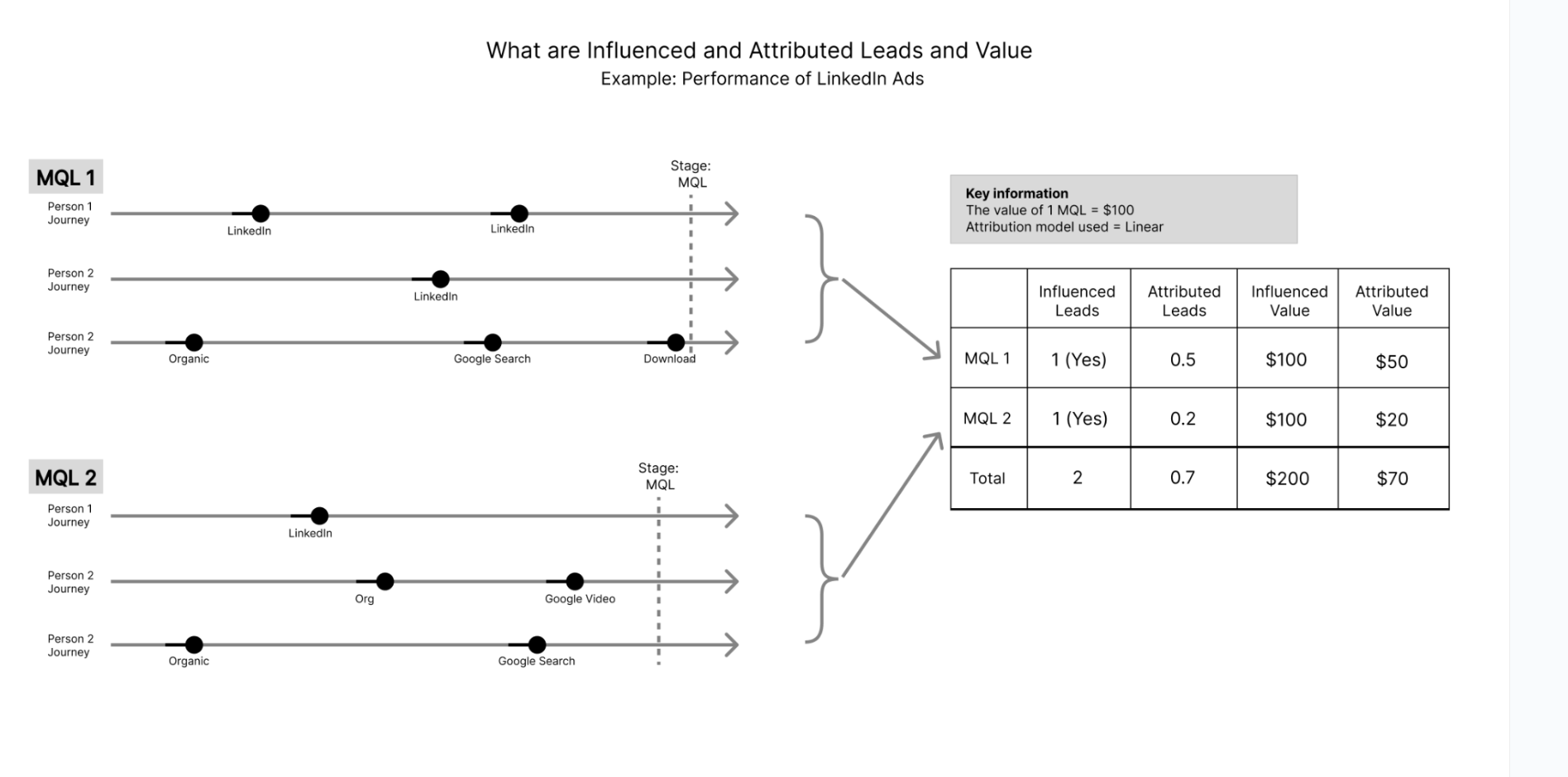Understanding: Influenced vs Attributed Leads and Value
At a glance
Influenced Leads: Any lead that has had at least one touchpoint with your campaign (e.g. clicked a LinkedIn ad).
Attributed Leads: Leads that your chosen attribution model (first/last touch, linear, W, U-shaped, data-driven) assigns some credit to.
Example: If you've chosen stage model MQL the business activity would be "Leads". If you on the other hand choose SQL, the business activity would instead be "Deals".
OBS: This all depends on whatever naming conventions you've made when you created your stage models.
How to differentiate between Influenced Leads and Attributed Leads
Influenced leads and Attributed leads are terms that you will encounter throughout the entire platform, and are essential for understanding, how Dreamdata attributes value to your stage models.

Influenced Leads
Let's start off with Influenced Leads.
Imagine you are running LinkedIn Ads and you are keen to understand if your LinkedIn Ads influenced any customers? Now, Influenced means exactly that!
- Did we catch the attention of anybody at these companies?
- Do we have people within the company who got attracted by our Linkedin Ads?
So Influenced leads refer to those, who have had at least one touchpoint with one of your campaigns.
Attributed Leads
On the other hand, we have Attributed Leads. Now Attributed Leads are a bit different than the previous one mentioned.
As we already know, attribution models assign credit to the specific touchpoint that directly contributed to generating the lead. Learn more about the attribution models here.
And Attributed Leads work just the same way!
They are leads that have been assigned a certain amount of credit due to the attribution model it is based on.
- These models are First and Last-touch, W-shaped, U-shaped, Linear, and Data-driven attribution models.
A key difference between Influenced and Attributed is that a lead can be counted in influenced multiple times whereas in attribution the lead is divided between the touch points. This also means that when you add up the influenced leads from all your campaigns it will sum to more leads than you actually had. On the other side with attribution it will sum to exactly the total number of leads.
Contextual example
To illustrate the difference let's have a look at the following example together:
Let's have a look at the illustration below, "MQL 1" represents a deal stage, and "MQL 2" represents another one.
These deal stages are composed of different stakeholders. In this example it's person 1, 2 and 3.
To the right you will see a table that represents the "performance summary by channel" table that you can actually find in the Dreamdata platform. Here you see the numbers for Influenced and Attributed Leads as well as Influenced and Attributed Value.
In this example, each MQL lead is worth $100. This is also seen as Influenced Value which is the total value of that deal stage.
Now the question is, did our LinkedIn Ads influence customer 1 (MQL 1)?
The answer is yes.
As shown in the model, we can see there are 6 touch points distributed to 3 people and 3 of these touch points are actually Linkedin Ads.
So naturally, in our table on the right, we can therefore see for "MQL 1" a yes and a number 1.

Same question for MQL 2, did LinkedIn influence this customer?
The answer is again, yes.
Out of the 5 touch points we have one person who was influenced by our LinkedIn Ads.
So on our table, on the right side, we can see for "MQL 2" a yes and a number 1.
However, "MQL 1" and "MQL 2" are not worth the same based on the amount of touch points they actually had with LinkedIn Ads.
Now, here comes the tricky part...
Because "MQL 1" had only half of the touch points related to Linkedin that gives us an attributed value of 0.5. If we then multiply our $100 by 0.5 we know that MQL 1 is worth $50.
Let's have a look at "MQL 2".
Here only 1 of the 5 touch points is related to Linkedin, which leaves us with an attributed value of 0.2. If we then multiply our $100 by 0.2 we know that "MQL 2 is" worth $20 as is also depicted in the table above.
So when we sum it all up, it results in a total value of $50 + $20 = $70
That means that $70 of the total $200 can be attributed to LinkedIn as also shown in the table above.
So in essence, the Attributed Value will always change depending on the attribution model chosen, but the Influenced Value will always stay the same as this reflects the amount of money this deal stage has been deemed worth.

